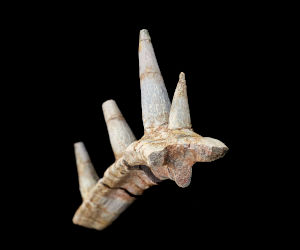The state of smart cities in MENA
11 December 2025
Published online 5 October 2021
The oldest ankylosaur fossil ever discovered, and the first from Africa, has a unique structure of armour spikes unlike that found in the rest of its family.

©Trustees of the Natural History Museum
The fossil has now been verified as genuine and attributed to a new species of ankylosaurs. It is the oldest known ankylosaur fossil, and also the first found on the African continent.
CT scanning confirmed the authenticity of the strange structure, and revealed a cross hatch pattern in the bone structure that is unique to ankylosaurs.
“It is completely unlike anything else in the animal kingdom,” says Susannah Maidment of the Natural History Museum in London, UK and first author of the research report1. The research team includes geologist, Driss Ouarhache of Sidi Mohamed Ben Abdellah University, in Fez, Morocco. Maidment says Ouarhache’s expertise in the layered geology of the region where the fossil was found was essential for its accurate dating.
In an unusual twist, the fossil came to the researchers from a dealer. It had been discovered in a region of Morocco they knew well as the site of the oldest known stegosaur fossil.
Paleontologist Caleb Brown, curator of Dinosaur Systematics & Evolution at the Royal Tyrrell Museum of Palaeontology in Alberta, Canada, who was not involved in the study, says it is an exciting discovery for several reasons. He emphasies the significance of the large armour spikes fused to the underlying rib, in contrast to the typical arrangement of ankylosaur armour, where the spikes are embedded within the skin tissue and not fused to bone.
“This adds to our understanding of the early evolution of armoured dinosaurs, and suggests there were some early forms with bizarre and unexpected armour that we are just now learning about,” Brown concludes.
Maidment named the newly identified ankylosaur species Spicomellus afer, after Spicomellus meaning ‘collar of spikes’ and afer meaning ‘of Africa’. In addition to the insight into ankylosaur structure and evolution, the discovery also yields new understanding of the geographical range of this group of dinosaurs.
The researchers are now keen to go back to the area and look for further surprises.
doi:10.1038/nmiddleeast.2021.81
Maidment, S. C. R. et al. Bizarre dermal armour suggests the first African ankylosaur. Nat. Eco. Evol. (2021).
Stay connected: